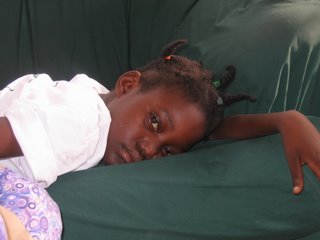
Sickle cell anemia is a big problem anywhere there are people of black descent. In the United States 1/400 African Americans have sickle cell anemia. Haiti is a country with greater than 8,000,000 black people densely packed onto a small island the size of the state of Maryland. Sickle cell disease is rampant here.
The mean survival of men in the United States with sickle cell disease is 42 years. The mean survival of women in the United States with sickle cell disease is 48 years. The mean survival of men and women in Haiti with sickle cell disease is about 25 years. If you are born with sickle cell disease in the developing world, you are in trouble.
The main problem with sickle cell anemia is that hemoglobin within the red blood cells is formed improperly which causes the blood to be sticky, not flow like it should, and this blood will occlude small blood vessels at the level of the organ and cause organ dysfunction.
So what does this mean for the little girl pictured in this post who was in the middle of a sickle cell crisis when this picture was taken. Pain is a big part of a crisis when blood flow becomes stagnant. Her feet hurt (dactylitis) as did other regions of her body, but she complained mainly of her feet. She did not want to walk.
Sickle cell disease allows infections to become more severe and the leading cause of death with sicklers is infection. However, involvement of renal, pulmonary, bone and joint, and the central nervous system (stokes), occurs frequently with this disease.
In the last several decades, in countries with resources, multiple improvements in the treatment of sickle cell disease has occurred which have improved the quality and quantity of people’s lives. These improvements have not occurred in Haiti on a large scale.
What could be done in Haiti to help kids with sickle cell disease?
1.Infection control and prophylaxis: Educate parents what they should watch for with their child with sickle cell. Fevers have to be respected. Immunizations to prevent bacterial and viral infections. This is not done in Haiti because the poor cannot pay for these “second generation” vaccines. Receive ongoing penicillin prophylaxis to prevent infection. Folic acid needs to be taken each day to build more red blood cells that are chronically being destroyed in the circulation of someone with sickle cell disease.
2.Pain management: Sickle cell disease is one of the most painful diseases on earth. The painful crises come and go. Narcotics are frequently necessary. This is not done in Haiti either.
3.Management of infection: Hospitalization is frequently necessary with appropriate blood tests, IV fluids, and powerful antibiotics. Where do poor people in Haiti go when their child needs to be hospitalized? Very few options exist at present.
4.Transfusion therapy: Blood transfusions and exchange transfusions need to be done. This can be safely done in the hospital setting, but in Haiti? Also, the transfused blood needs to be properly typed and screened and be free of infectious agents.
5.Hydroxyurea is a drug used all over the world to increase the amount of fetal hemoglobin which helps the patient with sickle cell disease. It is not available in Haiti for the poor. Hydroxyurea even decreases the incidence of strokes. A child with a stroke is always bad news.
Once again, Haiti’s medical system and the international community are failing Haiti with another disease. Haitians have big problems with sickle cell disease and it should be a priority.

No comments:
Post a Comment